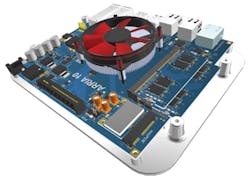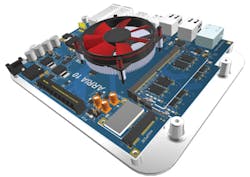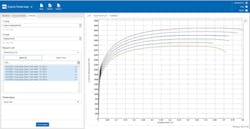Innovations span ECAD to test-program development
Makers of software closed out 2017 with new releases targeting a variety of application areas: ECAD for PCBs and subsystems, materials digitalization, additive manufacturing, and test automation and development. In addition, companies are looking to the past to predict the future as their tools evolve.
Focusing on ECAD for PCBs is Altium. The company’s goals with Altium Designer 18 are summed up in the phrase “high performance made simple,” according to Ben Jordan, director of community tools and content at Altium. Customer feedback, he said during a recent phone interview, suggests users want professional features that are easy to learn. The new release includes major performance improvements, a user-interface/user-experience overhaul, support for interconnected multiboard assembly, automated route tuning, enhanced BOM functionality, and enhanced power-distribution analysis. Also worth noting is a feature—FPGA support—not carried over from earlier releases. The company found that few customers would use the capability within the PCB design environment, relying instead on vendors’ dedicated EDA tools. “Altium Designer 18 has finally been able to make a clear break from FPGA design,” he said.
Jordan said Altium Designer 18’s 64-bit architecture provides access to more memory to better handle large designs. Jordan acknowledged that the move to 64 bits might seem late, and in fact, as outlined during a corporate presentation last May, 64-bit support began appearing with Altium Designer 16.1 However, Jordan said that up until now, the company was mainly focused on adding features, rather than on memory usage. Designer 18 will take full advantage of 64-bit capabilities while representing a transition from Delphi to Microsoft C#. Specifically, he said, processes including design rule checks and Gerber generation are now multithreaded, with Gerber generation running 150x faster, vs. Designer 16. Designer 18 also includes a new graphics engine that makes 2D to 3D switching almost instantaneous. Other multithreaded features are in development.
UI/UX overhaul
With regard to the user interface, Jordan described it as “fresh, modern, and easy on the eyes” with charcoal and blue appearance; it won’t, Jordan said, represent a drastic disruption for current users. Menus have been consolidated and restructured, with the removal of the DXP menu and all FPGA-related commands as well as “low usage” commands and panels. Other commands have been moved to more intuitive locations. An interactive properties panel supports single, consistent global-properties editing.
In addition, he said, a new Active Bar provides quick access to commonly used commands and is customizable via the normal toolbar editing process. A selection filter is available in the properties panel and Active Bar. A global search function that allows users to search on commands and preferences helps quickly find design information. A view configuration panel provides more immediate object and layer visibility control.
With regard to multiboard assembly (Figure 1), Jordan said a true system-level design connects both logical system design and physical-board assembly. The release adds a new project type: “Multi-board Design Project.” The multiboard schematic environment consists of a logical design environment that connects modules representing child designs, supporting multiple connection types, including direct and wire connections. Connection Manager traces connectivity across designs, and changes can be pushed from one design to another. The Multi-board Assembly environment physically connects PCBs in 3D space and performs collision checks, while component placement changes are pushed to child PCBs.
Automated route tuning
Jordan said Altium Designer 18’s automated route tuning with the ActiveRoute feature adds accordions to meet matched length rules, offering single-ended and differential-pair support. Tuning can occur while routing or as a post-process. Other ActiveRoute enhancements include pin swap during route, pad entry improvements, and meander and spacing control.
The new release also includes an overhaul of the ActiveBOM capability, which, Jordan said, results in a new, simplified UI that’s a single page rather than multitabbed, with multiple component views. It’s usable in Altium Vault and non-Vault flows. Supply-chain data is tied to manufacturer part number (MPN), and supplier parts are autoranked by availability and price. There’s also support for BOM checks and many customer-requested enhancements, including persistent item/line number and parameter/column name aliasing.
Finally, for power distribution network design, Altium Designer 18 is available with PDN Analyzer 2.0 (Figure 2), which Altium describes as powered by CST, a Dassault Systèmes brand. PDN Analyzer can help identify IR-drop problems that could, for example, cause a processor to reset or go into an indeterminate state when a current surge occurs, Jordan said. PDN Analyzer can show where to add more copper, for instance.
Jordan described PDN Analyzer 2.0 as easier to use, with a single panel rather than three separate panels; fully integrated within Altium Designer, it doesn’t require translation between different tools. It includes a new user interface and offers faster run times. Multiple power nets can be analyzed concurrently, with voltage- and current-limit checks and detailed text and graphical reports. Improved accuracy enables customers to quickly identify problems in today’s complex PCB designs, Jordan said.
Digitalization of materials knowledge
The digitalization of materials knowledge is the focus of Granta Design, which in December announced Granta MI version 11, the latest release of its materials information-management software. The company said more engineering enterprises than ever are rolling out programs to digitalize their materials information; Granta MI version 11 accelerates this process, with new features for deploying materials knowledge enterprise-wide, while ensuring consistency, accuracy, and traceability. Enhanced tools support visualization and analysis of test data, manage product risk, and ensure robust data management workflows.
Granta said the new release enables companies to create a single corporate materials information system, managing their own proprietary materials knowledge alongside comprehensive materials reference information. Granta MI apps enable users to explore, integrate, and apply this data. Many of these apps have been updated, the company said. For example, the latest version of MI:Explore (Figure 3), an intuitive web app that can be configured for specific user groups and applications, is easier to configure, via a simple admin interface, and offers faster loading and support for larger datasets. In addition, the latest version of the MI:Mat Analyzer app, which provides graphing and visualization capabilities to Granta MI users, has been enhanced with capabilities supporting statistical analysis of test data. Furthermore, version 11 features updates of MI:Enterprise Connect and MI:Materials Gateway—key software components that integrate material intelligence with product lifecycle management (PLM) systems and that support CAD and CAE tools.
“Through our conversations with the user community, we’re seeing the digitalization of materials knowledge go from ‘nice-to-have’ to a ‘must-have’ for any engineering enterprise,” commented Dr. Rob Davis, head of Granta MI product management at Granta Design, in a press release. “Granta MI accelerates that process. Version 11 rolls-up all of the changes we’ve made in the last year in response to customer feedback, and adds some more: a total of 380 changes to make the system faster, easier-to-use, and higher quality.”
Manufacture and test
Other recently released software updates span test program development to 3D printing. In the latter category, CoreTechnologie presented its new 3D Additive manufacturing software at the Formnext trade fair in November in Frankfurt. With the tool, CAD data for 3D printing processes can be processed and analyzed with test profiles regarding different rapid manufacturing procedures, as described in a January article on additive manufacturing.2 The company also said it is addressing virtual reality and augmented reality as well as additive manufacturing with version 4.1 of its 3D_Evolution CAX data-conversion software.
As for test development, Marvin Test Solutions recently introduced release 10 of its ATEasy, the test-executive and test-development software suite. ATEasy provides test engineers with the necessary tools to efficiently develop, debug, document, maintain, and execute test applications. MTS said it has continually invested in ATEasy with the goal to provide an ATE software product that is easy to use and maintain, offers unrivaled long-term supportability, and meets the demanding test requirements of today’s complex systems.
The software reached its 25th anniversary of commercial availability in July of 2016, when company founders explained that a goal of the software was to be easy enough for hardware engineers to use, but robust enough to be useful to software engineers. At the same time, a longtime customer described ATEasy as providing “…a highly structured intuitive test environment that allows for rapid integration of test systems.”3
The latest version, ATEasy 10, delivers faster run-times (up to 10x faster in benchmarked tests), new integrated user collaboration tools such as ATEasy Merge, .Net controls support, the ability to embed ATEasy run-time executables, a test log template that provides the ability to analyze test results, and backward compatibility with all previous versions.
“ATEasy is our flagship software product, and our goal from the beginning has been to make continuous improvements to enhance the product and allow users to be more efficient and productive without rewriting and modifying their existing code,” said Ron Yazma, VP of software engineering for Marvin Test Solutions and the architect of ATEasy, in a press release.
“With this version we have improved our run-time performance and added many collaboration features that were requested by our customers that have standardized their test development on ATEasy. This will help them to meet their most demanding test challenges.”
“The best software development and test executive suite in the business just got even better,” added Major General Stephen T. Sargeant, USAF (Ret.) and CEO of Marvin Test Solutions. “We’re excited to announce these new tools to current ATEasy users and to demonstrate once again that ‘We Make Test Easy.’”
Developed from the ground up as ATE software for test and measurement applications, ATEasy is the only commercially-available test development/test executive software with an integrated HAL (hardware abstraction layer) and full simulation capabilities, the company reports. Preserving test program development investment, ATEasy offers backward source and execution compatibility with all previous versions.
The software updates covered in this article were all released in the second half of 2017 and capped a year of software innovation. A key release from the first half of the year, in May at NIWeek in Austin, was National Instruments’ next-generation LabVIEW NXG 1.0, which the company said bridges the gap between configuration-based software and custom programming languages, with the goal of letting domain experts focus on the problem, not the tool.
“Thirty years ago, we released the original version of LabVIEW, designed to help engineers automate their measurement systems without having to learn the esoterica of traditional programming languages. LabVIEW was the ‘nonprogramming’ way to automate a measurement system,” said Jeff Kodosky, NI cofounder and business and technology fellow, known as the “Father of LabVIEW,” during NIWeek.4 “For a long time, we focused on making additional things possible with LabVIEW, rather than furthering the goal of helping engineers automate measurements quickly and easily. Now we are squarely addressing this with the introduction of LabVIEW NXG, which we designed from the ground up to embrace a streamlined workflow. Common applications can use a simple configuration-based approach while more complex applications can use the full open-ended graphical programming capability of the G LabVIEW language.”
As to what’s next for software platforms, Altium’s Jordan in a recent article5 looked to the past to predict the future, which he expects will be populated by multilayer 3D molded interconnect devices and as-yet unforeseen innovations. Success, he writes, will be “…just a matter of betting on the right horse,” adding that that horse could be you if you can adopt the appropriate evolving ECAD tools. “This industry is constantly evolving, and with that evolution must come new tools and techniques,” he writes.
As for test software, National Instruments reports in its Automated Test Outlook 2018 that it has conducted a five-year study of top performers in the test industry, showing that high-performing test software organizations invest in three key areas: the software engineering process, technical leadership, and a culture of learning. NI’s LabVIEW Center of Excellence program provides a structure for implementing best practices. ATO 2018 quotes Chris Forristal, software team leader at Valeo, as saying the Center of Excellence provided a forum for engineers to contribute to process improvements and guidance on quickly adopting those improvements. As for how LabVIEW will evolve to help address the goals of the program, clues are likely to emerge at NIWeek 2018, scheduled for May 21-24 in Austin.
References
- Nelson, Rick, “Altium presents 2020 PCB design roadmap,” EE-Evaluation Engineering Online, May 22, 2017.
- Nelson, Rick, “New system, software, and materials augment 3D printing,” EE-Evaluation Engineering, January 2018, p. 28.
- Nelson, Rick, “Customers weigh in on 25th anniversary of ATEasy commercial availability,” Rick’s Blog, EE-Evaluation Engineering Online, Aug. 29, 2016.
- Nelson, Rick, “NIWeek attendees see next generation of LabVIEW,” EE-Evaluation Engineering, Aug. 2017, p. 26.
- Automated Test Outlook 2018, National Instruments, 2017, p. 4.
For more information:
About the Author

Rick Nelson
Contributing Editor
Rick is currently Contributing Technical Editor. He was Executive Editor for EE in 2011-2018. Previously he served on several publications, including EDN and Vision Systems Design, and has received awards for signed editorials from the American Society of Business Publication Editors. He began as a design engineer at General Electric and Litton Industries and earned a BSEE degree from Penn State.



